Table of contents
- On the move with Kawasaki 250 S1, Suzuki T 250 and Yamaha RD 250 The three most beautiful Japanese 250cc machines
- Kawasaki S1: the shrillest blare from three pipes
- Suzuki T 250: the solid, classic two-stroke for all occasions
- Yamaha RD 250: The most powerful engine in the second best chassis
- Technical specifications
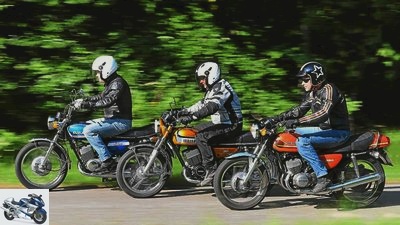
Jahn
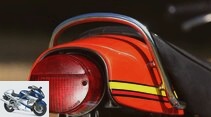

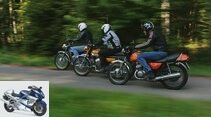
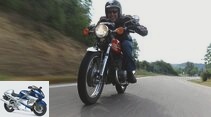
45 pictures
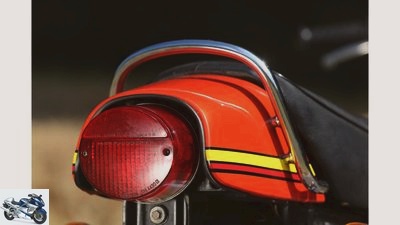
Jahn
1/45
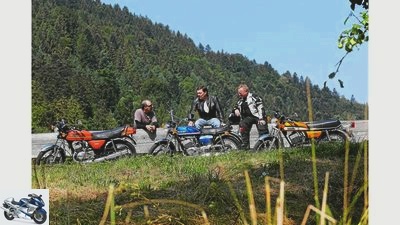
Jahn
2/45
Reminisce: For many, a 250cc two-stroke was the first real motorcycle in the 70s.
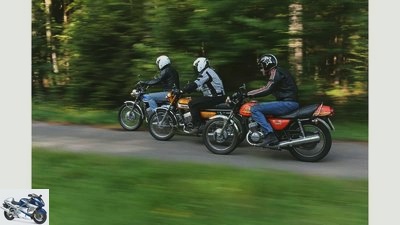
Jahn
3/45
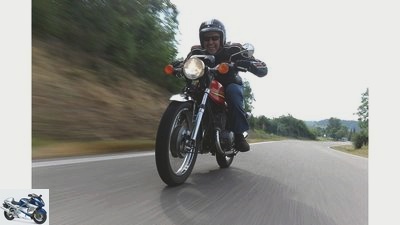
Jahn
4/45
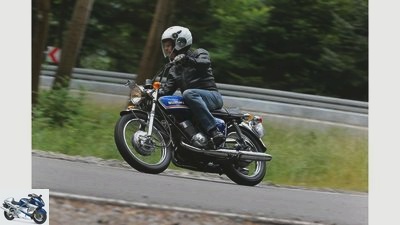
Jahn
5/45
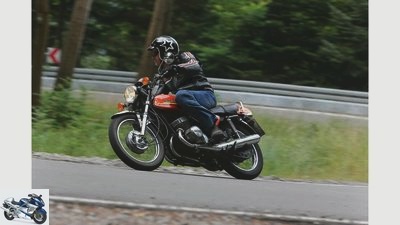
Jahn
6/45
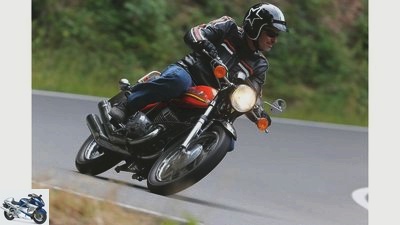
Jahn
7/45
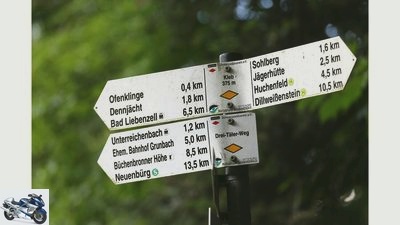
Jahn
8/45
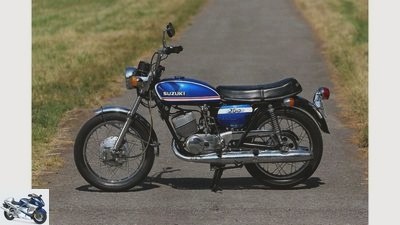
Jahn
9/45
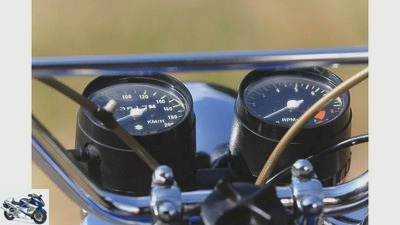
Jahn
10/45
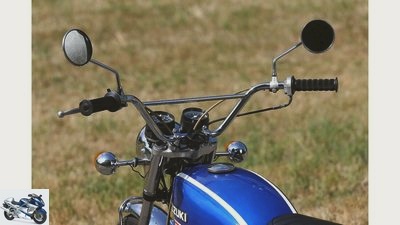
Jahn
11/45

Jahn
12/45

Jahn
13/45
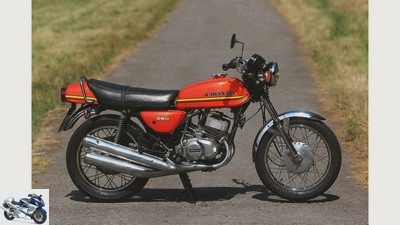
Jahn
14/45
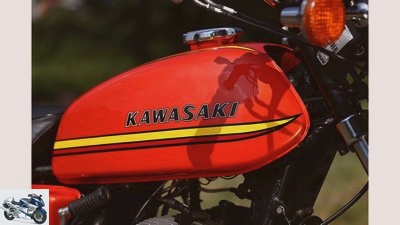
Jahn
15/45
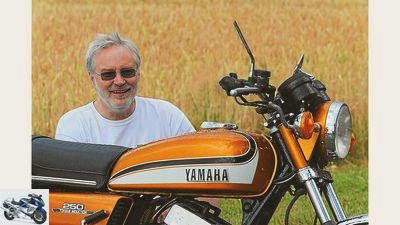
Jahn
16/45
In addition to a whole bunch of classic motorcycles, the Black Forest Yamaha fan Ingolf Reuter bought his RD “250” in memory of his first new motorcycle from 1973 and spiced it up with 350 cylinders, the most popular of all tuning measures.
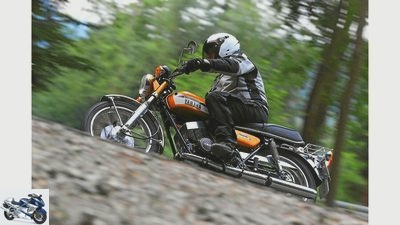
Jahn
17/45
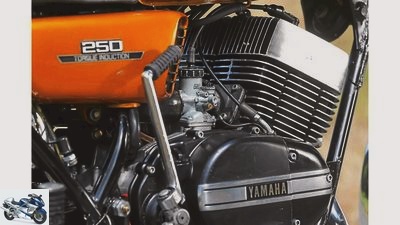
Jahn
18/45
Edgy journeyman: The RD motors relied on black and brushed aluminum.
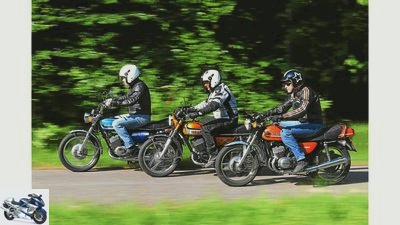
Jahn
19/45
At the beginning of the 1970s, they were the logical and above all affordable step from the 50s moped to the right motorcycle: the blaring quarter-liter two-stroke engines.
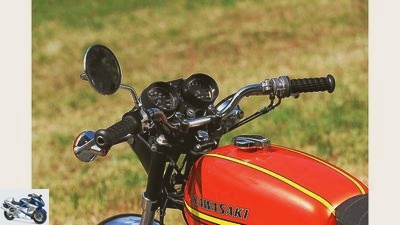
Jahn
20/45
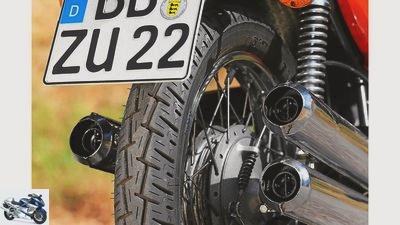
Jahn
21/45
Nice views: three asymmetrically routed silencers as a trademark.
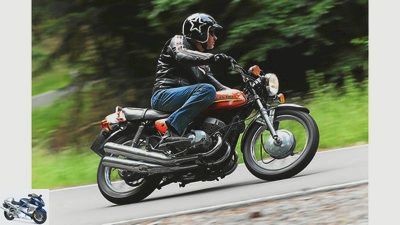
Jahn
22/45
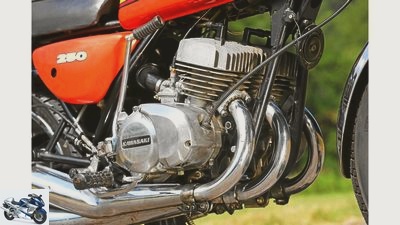
Jahn
23/45
It is also impressive: even as a small 250, the three-cylinder is an imposing appearance.
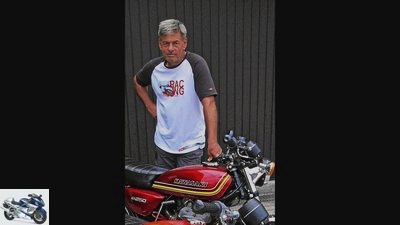
Jahn
24/45
The motorcycle dealer and owner of the Kawasaki 250 S1 Hendryk Peuker from Birkenfeld near Pforzheim (www.peuker-streeb.de) has been infected with the triple virus since the early 1970s and has roamed the Black Forest with pretty much all H models.
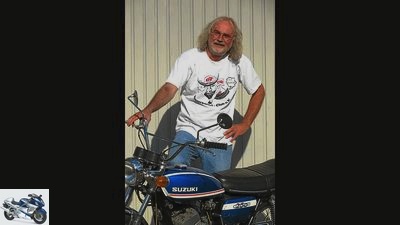
Jahn
25/45
You can’t miss it in his garage: Mathias Bohringer has been a Suzuki fan from the start and of course a member of the water buffalo club (www.wasserbueffel-club.de).
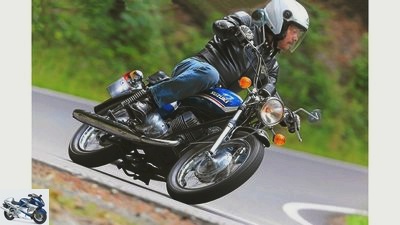
Jahn
26/45
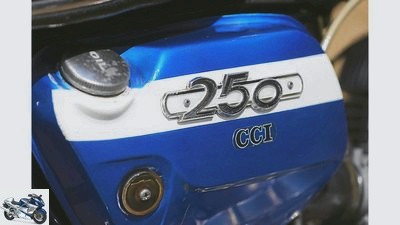
Jahn
27/45
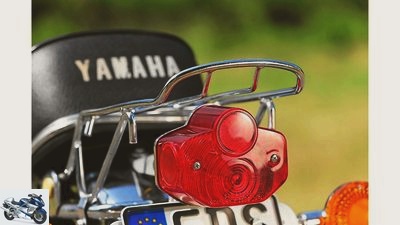
Jahn
28/45
A concession to suitability for everyday use: the petite luggage rack for the excursion to the quarry pond.
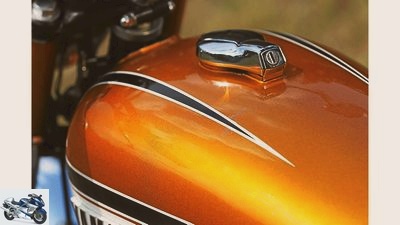
Jahn
29/45
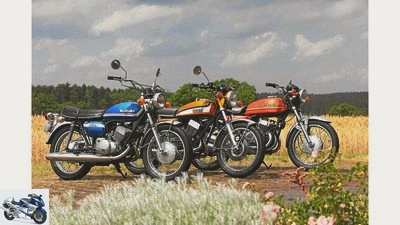
Jahn
30/45
… Tank, seat, handlebars, wheels and a stylish engine in between – done.
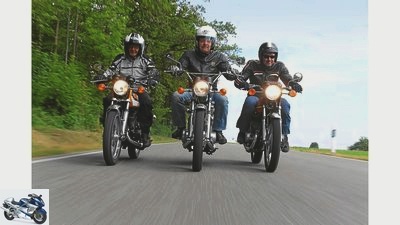
Jahn
31/45
Limitation to the essentials …
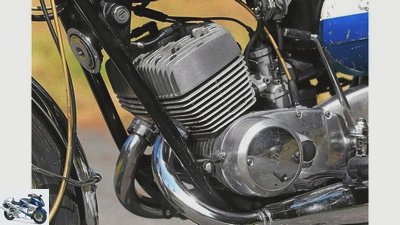
Jahn
32/45
T 250 cylinder with round ribs in bright aluminum silver. Breaker behind the chrome-plated sheet metal cover.
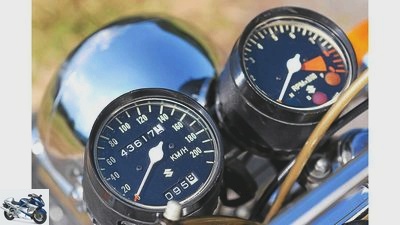
Jahn
33/45
Simply good: cut-out, no-frills round instruments.
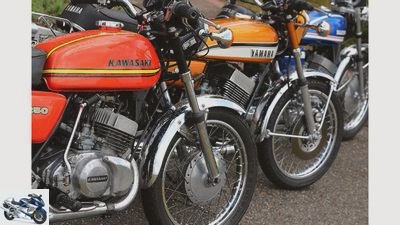
Jahn
34/45
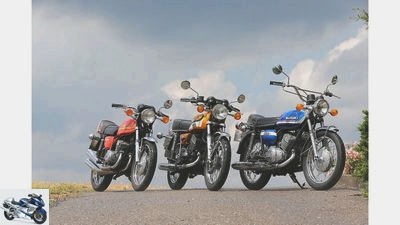
Jahn
35/45
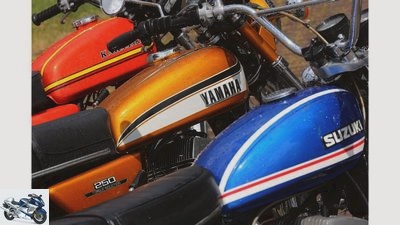
Jahn
36/45
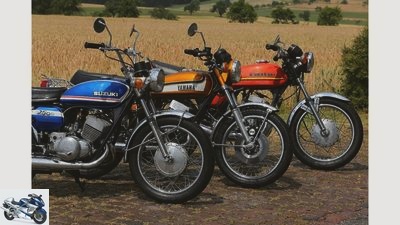
Jahn
37/45
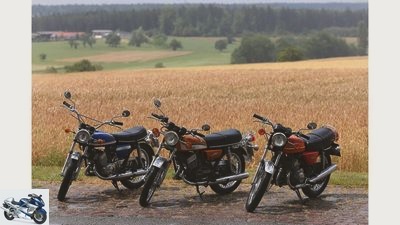
Jahn
38/45

Jahn
39/45
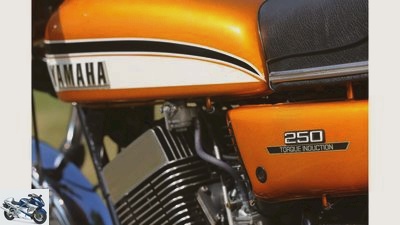
Jahn
40/45
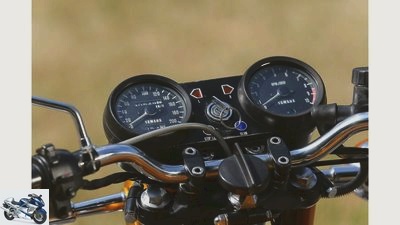
Jahn
41/45

Jahn
42/45
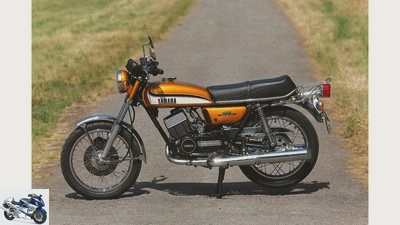
Jahn
43/45
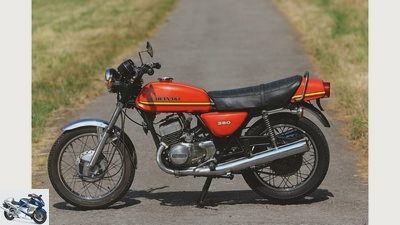
Jahn
44/45

Jahn
45/45
motorcycles
On the move: 250cc from Kawasaki, Suzuki and Yamaha
On the move with Kawasaki 250 S1, Suzuki T 250 and Yamaha RD 250
The three most beautiful Japanese 250cc machines
Content of
At the beginning of the 1970s, they were the logical and above all affordable step from the 50s moped to the right motorcycle: the blaring quarter-liter two-stroke engines. MOTORRAD editor Werner Koch is reviving the three most beautiful Japanese 250cc machines.
Werner Koch
08/29/2013
Old memories are mostly related to external circumstances. Like the music to the first girl, the familiar routes and curves stay in the memory when riding a motorcycle. Even 40 years later, you could still use the right gear or braking point for almost every bend in the northern Black Forest. From Schellbronn to Unterreichenbach, via Kaltenbronn to the Rote Laache and vice versa – that was the territory of our motorcycle clique!
Buy complete article
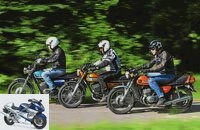
On the move with Kawasaki 250 S1, Suzuki T 250 and Yamaha RD 250
The three most beautiful Japanese 250cc machines
11 pages) as PDF
€ 2.00
Buy now
Full soup, there was no mercy on the last groove. For us it was Suzuki T 250, Yamaha The RD 250 and Kawasaki’s three-cylinder were not motorcycles, they were racing machines. Or they were remodeled into such. In view of the not inconsiderable fall rate, cold deformations were a welcome opportunity to replace dented series scrap with racing parts. Long stretched behind Italian racing tanks, with self-made footrests and deeply clamped Tomaselli handlebars, we ironed through the winding mountain stretches almost lying down. When MOTORRAD showed Bruno Kneubuhler dragging his knees on the cover, the leather on the knees of the crazy boys had to be patched with silver tape. Some people wore the heroic bandage just because it was chic, and you could make the sanding marks with a scrubbing file.
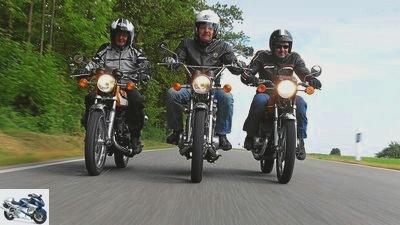
Jahn
Reduced to the essentials: tank, seat, handlebars, wheels and a stylish engine in between – done.
The braking point was set by rivalry, the choice of weapon – i.e. brand – on the other hand determined performance, driving behavior and above all the image. At this point I was really smeared with my Suzuki T 250, because only Yamaha showed what you could do with series machines in racing with the TD 2b and later with the TZ models. With the Suzuki there was not even anything to win in the Junior Cup – JuPo for short – and the three-cylinder Kawasakis were banned from racing by the regulations of the FIM world association, because after the escalating capers of the Japanese four- and six-cylinder factory machines In the mid-1970s, only two-cylinder engines were permitted.
But not only hot speeders like us made friends with the 250s, but also everyday drivers and tourists. Many drivers of an NSU Max, BMW R 25 or an English lady found the reliability of the Japanese two-stroke engines to be a real relief. Anyone who cared a little about the ignition timing, the correct heat value of the spark plugs and a clean flow of fuel – keyword piston jamming – easily cycled 30,000 kilometers with a T 250, RD or S1 without defects or failure. Then there were new pistons in the first oversize for a few marks, freshly ground cylinders – and the arbor was ready. At least with the good models. There were also less good ones. Which is why the Classic editorial team intervened very decisively in the selection of this trio. Because the Suzuki T 250 should have given way to a GT 250 K, strictly according to the year of construction.
But this cucumber with the screwed-on Ram Air hat was not only ugly and heavy, but also limp, fragile and in no way epoch-making. Which one can very well say about the pretty T 250. For our nostalgic trip around the Nagoldtal, however, we ignore the view that was focused on racing at the time, and enjoy the three two-stroke sweeps in peace. No jostling at the braking point, no slipstream battles, no risk – everything stays intact. Clear! After all, the three two-stroke speedsters are on loan from our Classic readers, to whom we would like to take this opportunity to thank them once again for their helpfulness and the nice stories about their motorcycles.
Kawasaki S1: the shrillest blare from three pipes
It was the big sister, the Mach III, that scared the motorcycle scene back then. “If you open your mouth at full throttle on the Kawa H1, your lungs will burst,” said the rumor at the Glemseck motorcycle meeting point near Stuttgart. Others claimed to have heard of dangerous brain anemia and fainting from the brutal acceleration. And that’s exactly why it built Kawasaki the “little monsters” with 250 and 350 cubic centimeters. Regardless of whether S1 or H1, when the tinny puddle at half throttle gives way to the screeching with open throttle valves over 7000 / min, the hairs on the back of the neck are still raised today.
Marketing was like a picture book, because from a purely technical point of view, switching from the fast 250/350 rotary valve Kawasakis of the A series to the three-cylinder did not bring any advantage. Heavier, wider and not really faster, the triples went like hot cakes anyway. Which is easy to understand when you go out with the trio.
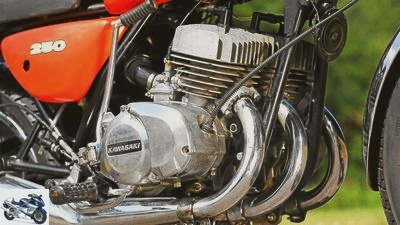
Jahn
Even as a smaller 250, the three-cylinder is an imposing appearance.
At first glance, it can hardly be distinguished from its big sister in terms of looks, but the small three-cylinder engine is surprisingly powerful at 3000 rpm and effortlessly flips through the rev range. Four transfer channels and the relatively small carburetor cross-section of 22 millimeters in connection with the long stroke (45 mm bore at 52.3 mm stroke) increase the overall pulling power rather than the maximum power and maximum speed. Compared to the replaced two-cylinder, the S1 only needs around 500 rpm more for its maximum performance. If you expect smooth running from the treble with its small pistons, you will be disappointed. This two-stroke engine also distributes its fine vibrations over the entire motorcycle. Which is no wonder with a three-cylinder with a 120-degree offset of the crank pin, which is also rigidly screwed into the frame.
Miracles cannot and should not be expected from the brakes and chassis of the Kawasaki. At the front a very similar to the Suzuki, but quite primitive fork with chrome-plated steel dip tubes sprung, at the rear two struts worked with a lot of hardness, but little damping. A conversion is recommended – then as now. Or you can choose a relaxed strolling pace on winding bumpy roads. And we don’t want to dare any more today.
Suzuki T 250: the solid, classic two-stroke for all occasions
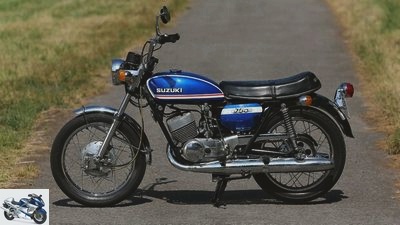
Jahn
Simply good: cut-out, no-frills round instruments. T 250 cylinder with round ribs in bright aluminum silver. Breaker behind the chrome-plated sheet metal cover.
As a former Suzuki mechanic with more than 80,000 passionate kilometers on a prepared T 250, I unfortunately cannot serve with the required journalistic neutrality. Guys, don’t hold it against me. And see it as a belated declaration of love for a motorcycle that for me is one of the best and most reliable of the early 1970s. The reason is very simple: I only had to go out with the trailer once because I had rolled the T 250 into the bushes in the notorious shadow curve on the Solitudering.
Otherwise, the Suzi ran like clockwork, and not just thanks to the CCI direct lubrication. Defects, for example that of the right crankshaft oil seal, announced themselves so early that it easily reached home. So it’s no wonder that when you reach for the ignition key on the left under the tank, you’re back home. Clip, choke down, kick twice – what a lively, rich sound. Hangs on the gas like Harry, starts idling like Harry and turns like Harry. You don’t really know who and how Harry is, but you know what to expect from Harry. Something like the T 250 engine, for example.
The sober, factual confirmation of my very subjective hymn of praise can be read in black and white in MOTORRAD 23/1971. Quote from Ernst “Klacks” Leverkus: “The T 250 turned out to be the fastest 250cc machine of the last few years with the real 27 DIN HP …”. That’s what I’m saying. But not with the deep chest tone of conviction, because when you look into the cylinder it looks more like the classic German Schnurle reverse flush than Japanese engineering. Two overflow channels, inlet channel with separator for better piston guidance, perfectly normal outlet shape, the whole thing fed by a 26 mm Mikuni carburettor with aluminum round slides. Good enough for the road, just too little for sport. That didn’t stop me from upgrading the T 250 engine with large ducts, long valve timing (according to tuning instructions from the English Motorcycle News) and the open 32 mm carburetors of the T 500.
Back then, long lying in Hockenheim was a speed of 175 km / h, measured by a MOTORCYCLE light barrier. Which roughly suggested 35 hp and was good for lap times of 1.22 minutes on the small Hockenheim circuit. Because the stable chassis of the T 250 was far superior to the engine, although such virtues were the exception in the early 1970s. Also said no brainer: “No handlebar swaying, no sideways breaking, no hopping. The best chassis in this class. ”It was the T 250 and the large GT models, but above all the committed team from Zweirad Roth in Hammelbach as importer that paved the way for Suzuki to become one of the most successful motorcycle brands in Germany.
Yamaha RD 250: The most powerful engine in the second best chassis

Jahn
A concession to suitability for everyday use: the petite luggage rack for the excursion to the quarry pond. Edgy journeyman: The RD motors relied on black and brushed aluminum.
However, the Yamaha gearbox caused a stir with us. Announced worldwide with the usual six gears, we first had to tinker with the brand new RD 250 from the Spezl for a whole Saturday until the locked sixth gear was ready for use. Illegal, of course, because of the noise. As if someone had cared if the thing ran 160 instead of 146 km / h. For the specialist, however, it was a tragedy that the first RD 250 actually only ran 146.63 km / h during the test in MOTORRAD 6/73 – note the meticulously determined second digit after the decimal point.
More was not possible because the membrane motor started to spin at 8300 rpm and suddenly stopped working. Tired 146.63 km / h with 30 hp – that of course amused us in the Suzuki group a lot. But there was no brainer. And he immediately worked out the optimal final ratio for the RD 250. In fact, with 16/36 instead of 14/36 teeth, the 160 km / h forecast for 30 hp – more precisely: 159.29 km / h – was achieved. But there was another way. The Yamaha freaks from Schafer & Bach in Stuttgart had the hang of it. Special jets and small changes to the periphery gave the RDs a huge boost. Well over 33 hp made her the boss in the ring. And that in the proverbial sense, because the hard-fought “reliability races”, or Zuvis for short, were dominated in the 250 and 350 classes by the RD pack with a few exceptions.
Also because the RD engine with its five transfer channels and the membrane control of the 28 mm carburetor set the course for the future. A few years later, the Yamaha construction principle was the basis for almost all powerful road two-stroke engines, with the exception of the rotary valve construction on the Suzuki RG 500 engine.
That Yamaha was right with the seriously stable chassis and the disc brake with two-piston calipers is confirmed on our little trip. In addition to me, Ottmar “Otti” Kissinger, my loyal racing mechanic, T 250 owner from the very beginning and currently on the road in an RD 350 YPVS, takes his hat off to the RD 250. but the sum of its driving characteristics makes it clear why the Yamahas dominated from 1973 onwards. Regardless of whether Suzuki with the GT 250 A, Maico with their MD 250 WK or Benelli / Moto Guzzi with the 250 2C opposed it, the RDs remained dominant up to the 250 LC. Which is also shown here on the old house route. How nice to refresh the old stories with the old two-stroke ratchets and old friends. More of them soon.
Technical specifications

Jahn
Reminisce: For many, a 250cc two-stroke was the first real motorcycle in the 70s.
Kawasaki 250 S1 / A
Engine: air-cooled three-cylinder two-stroke engine, slot-controlled, separate lubrication
Bore x stroke: 45 x 52.3 mm
Displacement: 249 cm3
Power: 32 hp at 8500 rpm
Power transmission: primary drive via helical gears, multi-disc oil bath clutch, five-speed gearbox, roller chain
Chassis: double loop frame made of tubular steel, telescopic fork, Ø 38 mm, two-arm swing arm, wire-spoke wheels with chrome-plated steel rims, tires 3.00-18 front, 3.25-18 rear, drum brake front, Ø 180 mm, drum brake rear, Ø 180 mm
Weight with a full tank: 155 kg
Top speed: around 150 km / h
Construction time: 1973
Suzuki T 250
Engine: air-cooled two-cylinder two-stroke engine, slot-controlled, separate lubrication
Bore x stroke: 54 x 54 mm
Displacement: 247 cm³
Output: 27 hp at 8000 rpm
Power transmission: primary drive via helical gears, multi-disc oil bath clutch, six-speed gearbox, roller chain
Chassis: double loop frame made of tubular steel, telescopic fork, Ø 38 mm, two-arm swing arm, wire-spoke wheels with chrome-plated steel rims, drum brake at the front, Ø 180 mm, drum brake at the rear, Ø 180 mm
Weight: 143 kg with a full tank
Top speed: around 150 km / h
Construction time: 1969 – 1972
Yamaha RD 250
Engine: Air-cooled two-cylinder two-stroke engine, diaphragm-controlled, separate lubrication
Bore x stroke: 54 x 54 mm
Displacement: 247 cm3
Output: 30 hp at 7500 rpm
Power transmission: primary drive via helical gears, multi-disc oil bath clutch, six-speed gearbox, roller chain
Chassis: Double loop frame made of tubular steel, telescopic fork, Ø 38 mm, two-arm swing arm, wire-spoke wheels with chrome-plated steel rims, tires 3.00-18 at the front, 3.50-18 at the rear, disc brake at the front, Ø 270 mm, drum brake at the rear, Ø 180 mm
Weight with a full tank: 144 kg
Top speed: around 160 km / h
Construction period: 1973 – 1975
Related articles
-
Unusual motorcycles from Ducati, BMW, Suzuki and Yamaha
Jahn 23 pictures Jahn 1/23 Ducati Diavel: The devil’s roast from Bologna surprised the motorcycle world, its success even Ducati. Jahn 2/23 Ducati Diavel…
-
Middle class bikes from Yamaha, Kawasaki, Suzuki and Honda
fact 27 pictures fact 1/27 Comparison of mid-range motorcycles from Yamaha XJ6 Diversion F, Kawasaki ER-6f, Suzuki GSX 650 F and Honda CBF 600 S. fact…
-
Comparison test between Suzuki DL 1000 V-Strom and Yamaha TDM 900
Artist motorcycles Comparison test between Suzuki DL 1000 V-Strom and Yamaha TDM 900 Comparison test between Suzuki DL 1000 V-Strom and Yamaha TDM 900…
-
Honda CBF 600 S, Suzuki Bandit 650 S, Yamaha FZ6 Fazer
Rossen Gargolov 17th pictures Suzuki 1/17 Suzuki 2/17 Suzuki 3/17 Suzuki 4/17 Suzuki 5/17 Suzuki 6/17 Suzuki 7/17 Suzuki 8/17 Suzuki 9/17 Suzuki 10/17…
-
Comparison test Kawasaki Versys 650, Suzuki V-Strom 650 and Yamaha Tracer 700
www.factstudio.de 27 pictures www.factstudio.de 1/27 Crossover comparison test with the Kawasaki Versys 650, Suzuki V-Strom 650 and Yamaha Tracer 700….
-
Big bikes from Honda, Suzuki, Kawasaki and Yamaha
archive counselor Used purchase Big bikes from Honda, Suzuki, Kawasaki and Yamaha Buying advice: big bikes The big bike generation from 1984 Content of…
-
Bargains from Honda, Kawasaki, KTM and Suzuki
jkuenstle.de motorcycles Bargains from Honda, Kawasaki, KTM and Suzuki Honda CBR 250 R, Kawasaki Ninja 300 R, KTM 200 Duke, Suzuki Inazuma 250 Four…
-
Comparison test: Honda Hornet, Kawasaki Z 750, Suzuki GSR 600
Jahn motorcycles Comparison test: Honda Hornet, Kawasaki Z 750, Suzuki GSR 600 Comparison test: Honda Hornet, Kawasaki Z 750, Suzuki GSR 600 ABS shooters…
-
Comparison test: Honda CBF 1000 Silverline, Suzuki Bandit 1250 S, Yamaha FZ1 Fazer
Jahn 22nd pictures Honda 1/22 Honda CBF 1000 Honda 2/22 Honda CBF 1000 Zdrahal 3/22 Presentation at the fair in Paris. Honda 4/22 Honda CBF 1000 Honda…
-
Comparison test BMW K 1300 R, Buell 1125 CR, Suzuki B-King, Yamaha Vmax
K 37 pictures Yamaha 1/37 First look at the device from all sides… Yamaha 2/37 Yamaha 3/37 Yamaha 4/37 Yamaha 5/37 Yamaha 6/37 Yamaha 7/37 What is…